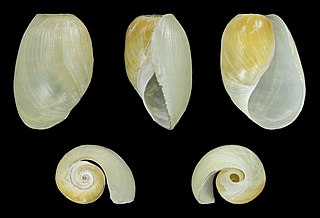
Bulla is a genus of medium to large hermaphrodite sea snails, shelled marine opisthobranch gastropod molluscs. These herbivorous snails are in the suborder Cephalaspidea, headshield slugs, and the order Opisthobranchia.

Marginellidae, or the margin shells, are a taxonomic family of small, often colorful, sea snails, marine gastropod molluscs in the clade Neogastropoda.

Scaphella is a genus of large sea snails, marine gastropod mollusks in the family Volutidae, the volutes.

Steromphala cineraria is a species of small sea snail, a marine gastropod mollusc in the family Trochidae, the top snails.

Euspira nitida, the common necklace shell, is a species of sea snail, a marine gastropod mollusc in the family Naticidae, the moon snails.

Akera bullata, named the royal flush sea slug, is a species of sea snail, a marine opisthobranch gastropod mollusk in the family Akeridae, a family that is related to the sea hares. This species is the only European representative of the genus Akera.

Citharomangelia pellucida is a species of sea snail, a marine gastropod mollusk in the family Mangeliidae.

Clavus exasperatus, common name the exasperating turrid, is a species of sea snail, a marine gastropod mollusk in the family Drilliidae.

Asperdaphne is a genus of sea snails, marine gastropod mollusks in the family Raphitomidae.

Exomilus is a genus of sea snails, marine gastropod mollusks in the family Raphitomidae.

Pseudoliva is a genus of sea snails, marine gastropod mollusks in the family Pseudolividae.

Monilea is a genus of sea snails in the family Trochidae, the top snails.

Toledonia is a genus of sea snails, marine gastropod molluscs in the family Cylichnidae.

Retusa is a genus of very small head-shield sea snails or barrel-bubble snails, marine gastropod molluscs in the family Retusidae.

Genota is a genus of sea snails, marine gastropod mollusks in the family Borsoniidae.

Akera bayeri is a species of sea snail, a marine opisthobranch gastropod mollusk in the family Akeridae, a family that is related to the sea hares.
Akera julieae is a species of sea snail, a marine opisthobranch gastropod mollusk in the family Akeridae, a family that is related to the sea hares.

Akera soluta is a species of sea snail, a marine opisthobranch gastropod mollusk in the family Akeridae, a family that is related to the sea hares.



















